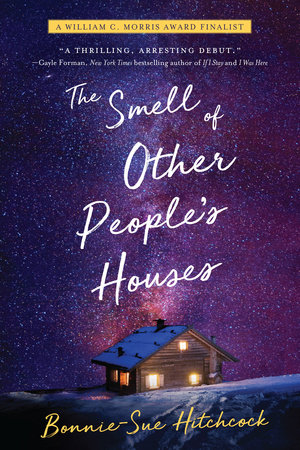The Smell of Other People Houses by Bonnie-Sue Hitchcock
Author:
Born and raised in Alaska, I now live and write in a yurt on a dome near Fairbanks. Before writing fiction, I spent many years working as a journalist for Alaska public radio stations all around the state. I also spent time commercial fishing with my family in Southeast Alaska.
Besides young adult literature, I have written news stories, short stories, essays, and poetry. My work has appeared in The Anchorage Daily News, High Country News, The Los Angeles Review, Sonoma Review, National Public Radio and elsewhere—as well as a notable mention in The Best American Essays of 2015.
Reviews by our book club members:
“I have been reading the book, a little difficult, too much slang, but it has been clear to me and I have been able to travel to Alaska, see its white and blue colors, smell like fishing and learn a little about its customs. Also living some very emotional stories in a rural society, with the good and bad of living in such a narrow circle in the 70s, where everyone knows everyone's life but emotional support is also sought in this small community. This is what has surprised me the most, the familiarity between them. Sometimes they are hard stories in a time where marital relationships, abuse, mistreatment or relationships between parents and teenagers are called into question.
This story is a song of heartbreak, tenderness and indifference towards young people. It is important the Images as:
“I stare at those women who used to scare me, fluttering around in their black clothes like bats”
“in autumn everything smells ripe, as if in a hurry to change, before the arrival of winter”
“the seasons are like watercolors“
“The dancer looks like a wax statue, she seems to melt drop by drop due to the heat”
The story gains drama in the second part when Dora confronts the grandmother and especially in the scene in which she confronts her father and talks about the mistreatment of her mother and the abuse committed in her childhood. I find it is very hard or dramatic story . It is a very human, tragic book, with scenes of daily life in the very repressed context of the 70s. But above all it surprises me when it says that relatives are not only blood. It is different from the our globalized world. They live poor but they are not alone. Together they form a family and help each other. I like the four voices that define the characters, but I haven't quite understood Selma’s role, I think she is underage to carry two young people (something has happened to me here or I don’t understand it). Also, It does not seem plausible to me, that two minors can cross a country with a social worker without being detained by the justice system.”
PRR
Praise:
“An exquisitely drawn, deeply heartfelt look at a time and place not often addressed. Hitchcock’s measured prose casts a gorgeous, almost otherworldly feel over the text, resulting in a quietly lovely look at the various sides of human nature and growing up in a difficult world.” —Booklist, Starred
“Using alternating narratives, debut novelist Hitchcock deftly weaves these stories together, setting them against the backdrop of a native Alaska that readers will find intoxicating. . . . will resonate with readers of all ages.” —Publishers Weekly
“An affecting story of fractured love and surprising redemption.” —Shelf Awareness, Starred
“A multifaceted glimpse into [a] rich cast of characters. . . . An excellent debut.” —SLJ
“The Alaskan author depicts places and an era rarely seen in fiction for teens….All benefit from her journalist’s eye for detail.” —Kirkus Reviews
“Grounded in emotional honesty.” —The Horn Book
“An honest, gritty, and moving portrait of growing up in Alaska. Only someone who knows and loves this place through and through could tell this story. This book is Alaska.” —Eowyn Ivey, author of the New York Times bestseller The Snow Child
“As only a native of Alaska can, Bonnie-Sue Hitchcock blends narratives of indigenous and non- into a buffet of pain and beauty. Highly recommended.” —Tim Tingle, author of the series How I Became a Ghost
“Hitchcock’s debut resonates with the timeless quality of a classic. This is a fascinating character study—a poetic interweaving of rural isolation and coming-of-age.” —John Corey Whaley, award-winning author of Where Things Come Back and Highly Illogical Behavior
Radio Interview (12 minutes):
https://www.bigcabbageradio.org/2016/02/24/bonnie-sue-hitchcock-interview-2-12-2016/
Read More:
- Interview with the author https://www.yalsa.ala.org/thehub/2017/01/19/23101/
- Article in School Library Journal https://www.slj.com/story/the-last-frontier-bonnie-sue-hitchcock-on-the-smell-of-other-peoples-houses
- Window on the world: Bonnie-Sue Hitchcock's Alaska – in pictures https://www.theguardian.com/childrens-books-site/gallery/2016/apr/11/bonnie-sue-hitchcock-alaska?CMP=share_btn_tw




Comentarios
Publicar un comentario